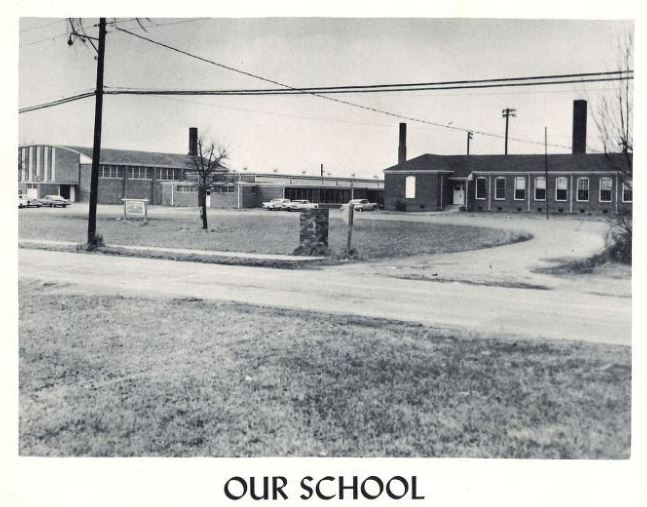
Thanks to our new partner, Union County Public Library, DigitalNC now features 3 yearbooks [1956, 1958, and 1962] from Winchester Avenue High School, which was the Black high school in Monroe, North Carolina. Winchester first opened as a K-12 school serving the Black community in the 1920s. It was an important institution in Monroe’s Black community, serving as a community center and point of pride for the many students who graduated from the school. That all changed in March 1966 when a fire heavily damaged the school. The high school students and teachers were sent to Monroe High School for the remainder of the 1965-1966 school year, making it the first fully integrated high school in the state. Though plans were already in place for the students to attend Monroe in the 1966-1967 school year, the fire forced the time table for this to speed up. It was particularly hard on some of the seniors of Winchester, who thought that they would be the last graduating class of the historic school. The extra celebrations that were being organized for the “last” class never took place. The lower grades of Winchester were able to continue the school year in the building that was undamaged as well as the gymnasium. It is also believed that the community center and some area churches housed some students.*
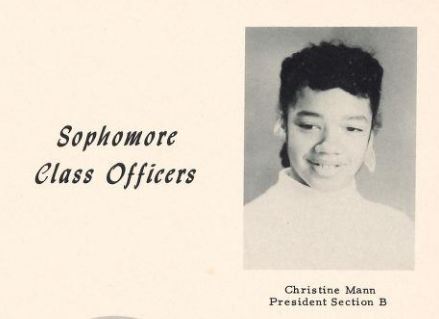
One of Winchester’s graduates is a trailblazer whose story has been highlighted very recently, Christine Darden. Darden is a retired engineer and executive from NASA Langley Research Center in Hampton, VA, and her story is one of the one’s highlighted in the book “Hidden Figures: The American Dream and the Untold Story of the Black Women Mathematicians Who Helped Win the Space Race.” Darden [Christine Mann is her maiden name] attended Winchester School through sophomore year before transferring to the Allen School, a boarding school in Asheville in 1956. She served as a sophomore class officer while at Winchester. 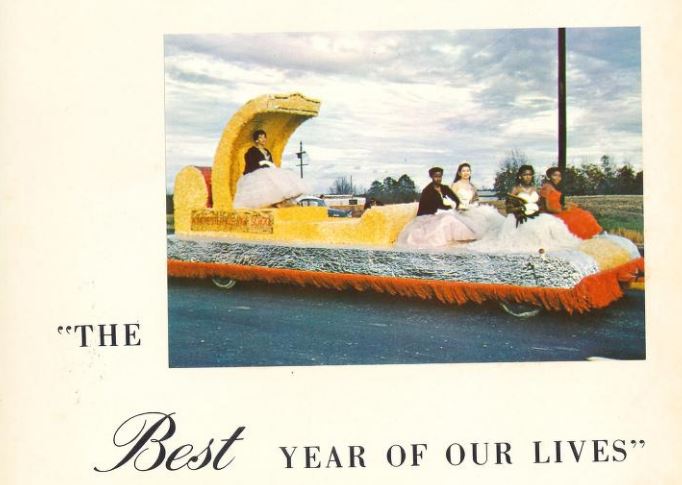
To learn more about our new partner, Union County Public Library, visit their partner page here. To see more yearbooks from across North Carolina, visit here.
*Thanks to Patricia Poland for additional information related to the school fire and its aftermath.
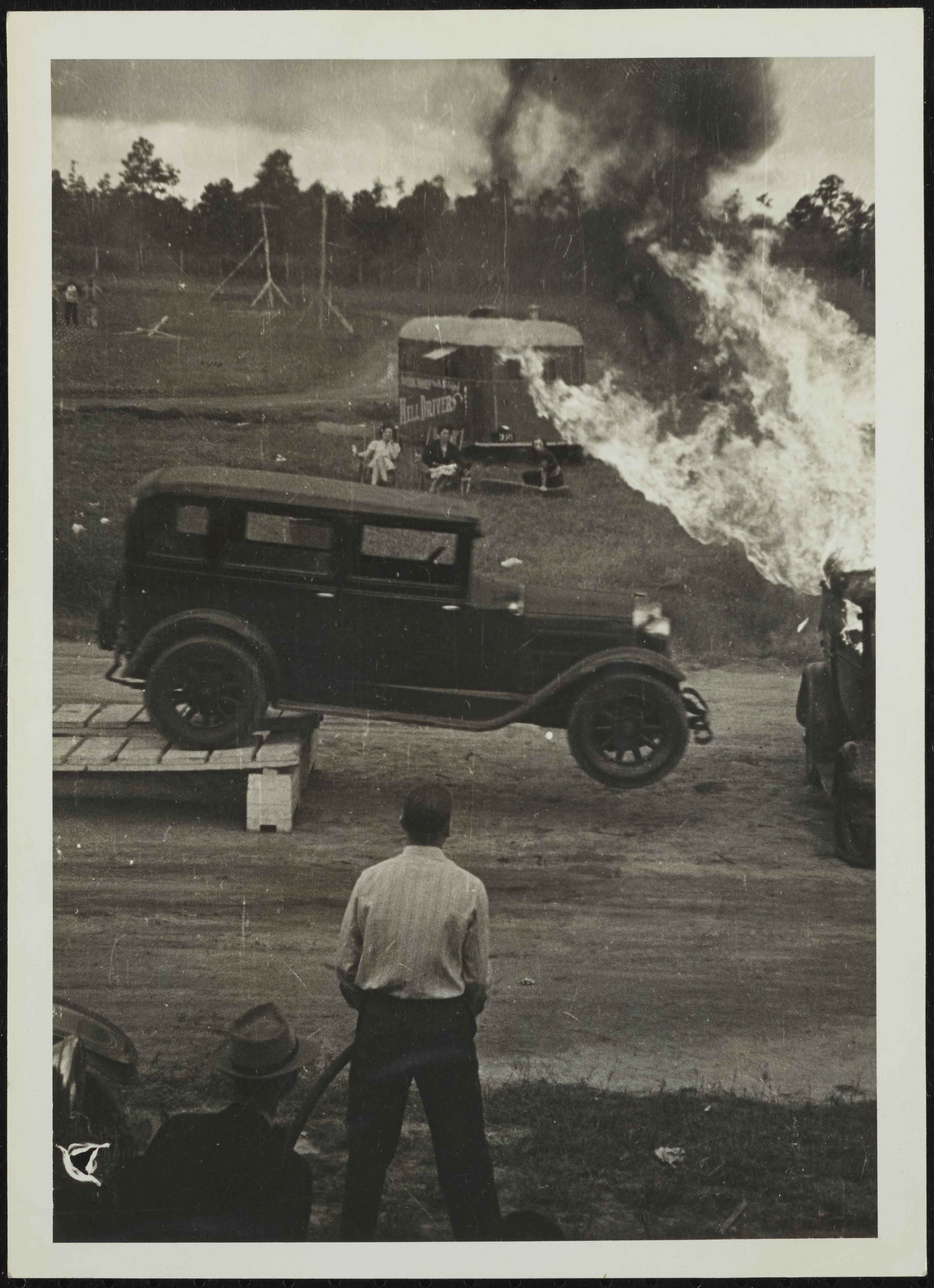
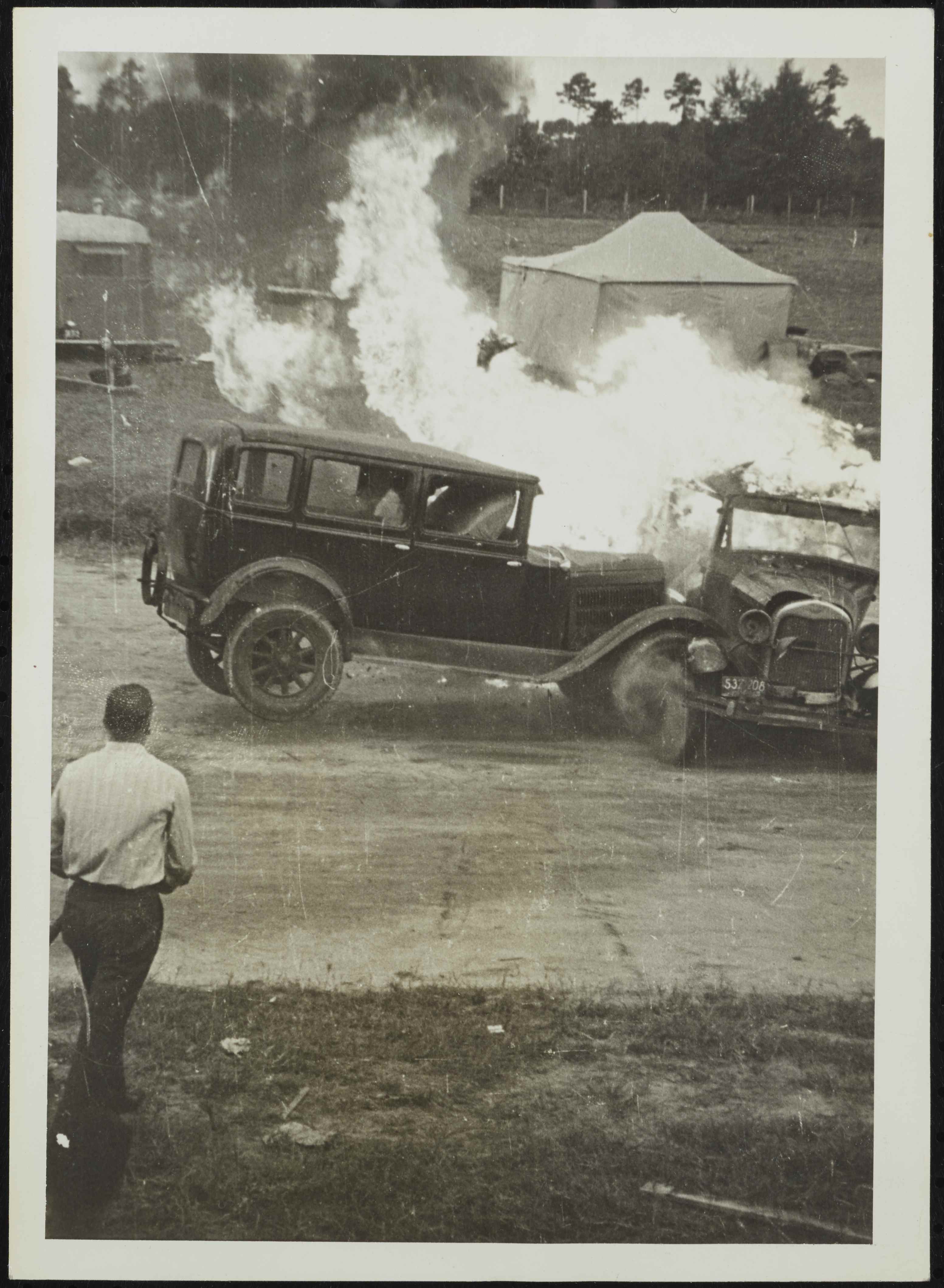
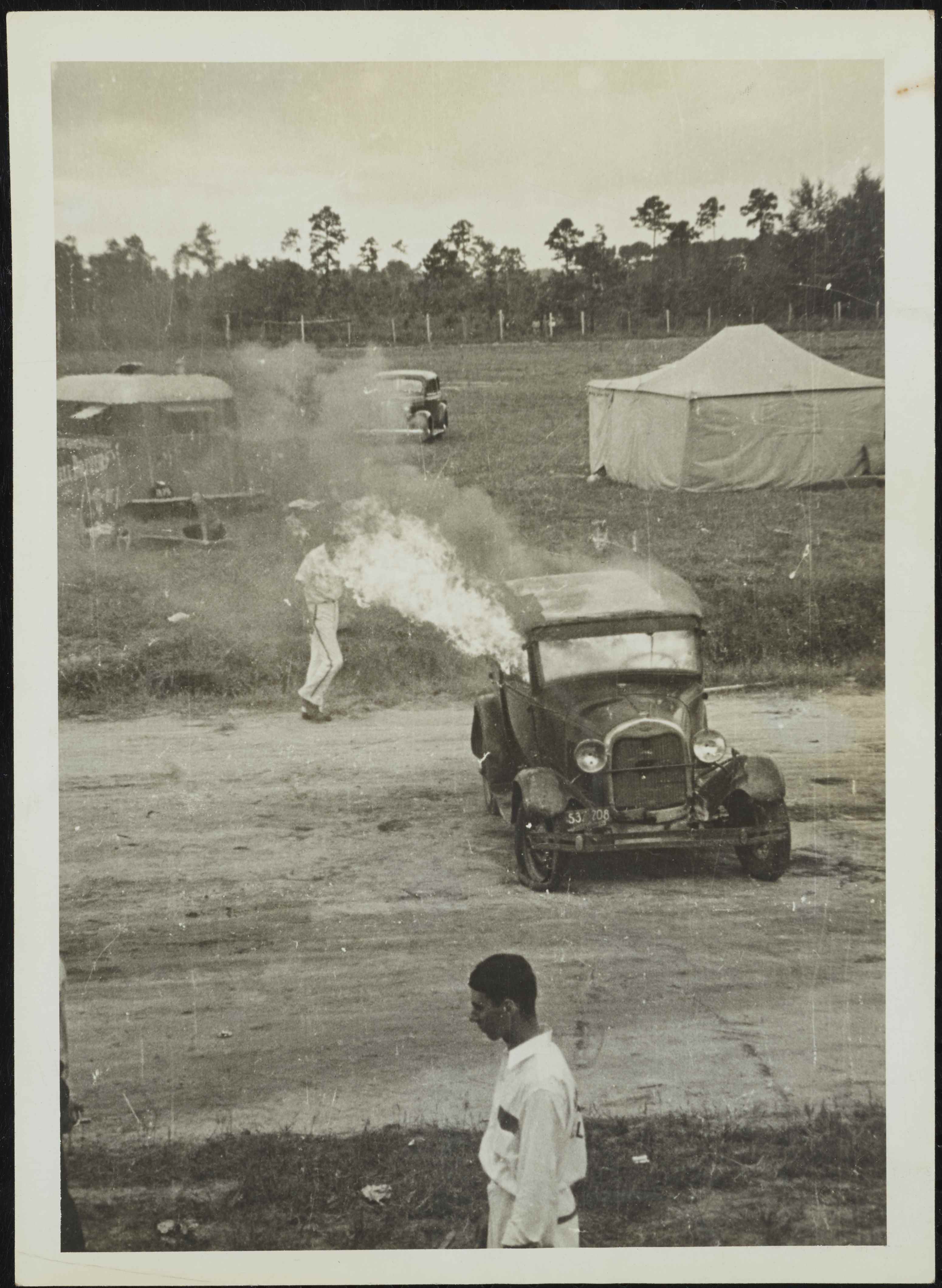
Above photos: 1939 Fair and Helldrivers, Image 37, 38, 39
The Hell Drivers (pictured above) were a prominent feature at the 1939 State Fair in Raleigh, N.C. They were also a prominent feature of amateur photographer, M.S. Brown’s, documentation of the fair. Fires, stunt drivers, flipped vehicles, and crashes were all part of this exciting show!
In addition to these photographs of the State Fair, more than 200 other new photos are now available on DigitalNC, added to the M.S. Brown Collection. Thanks to the Edgecombe County Memorial Library, this collection continues to grow.
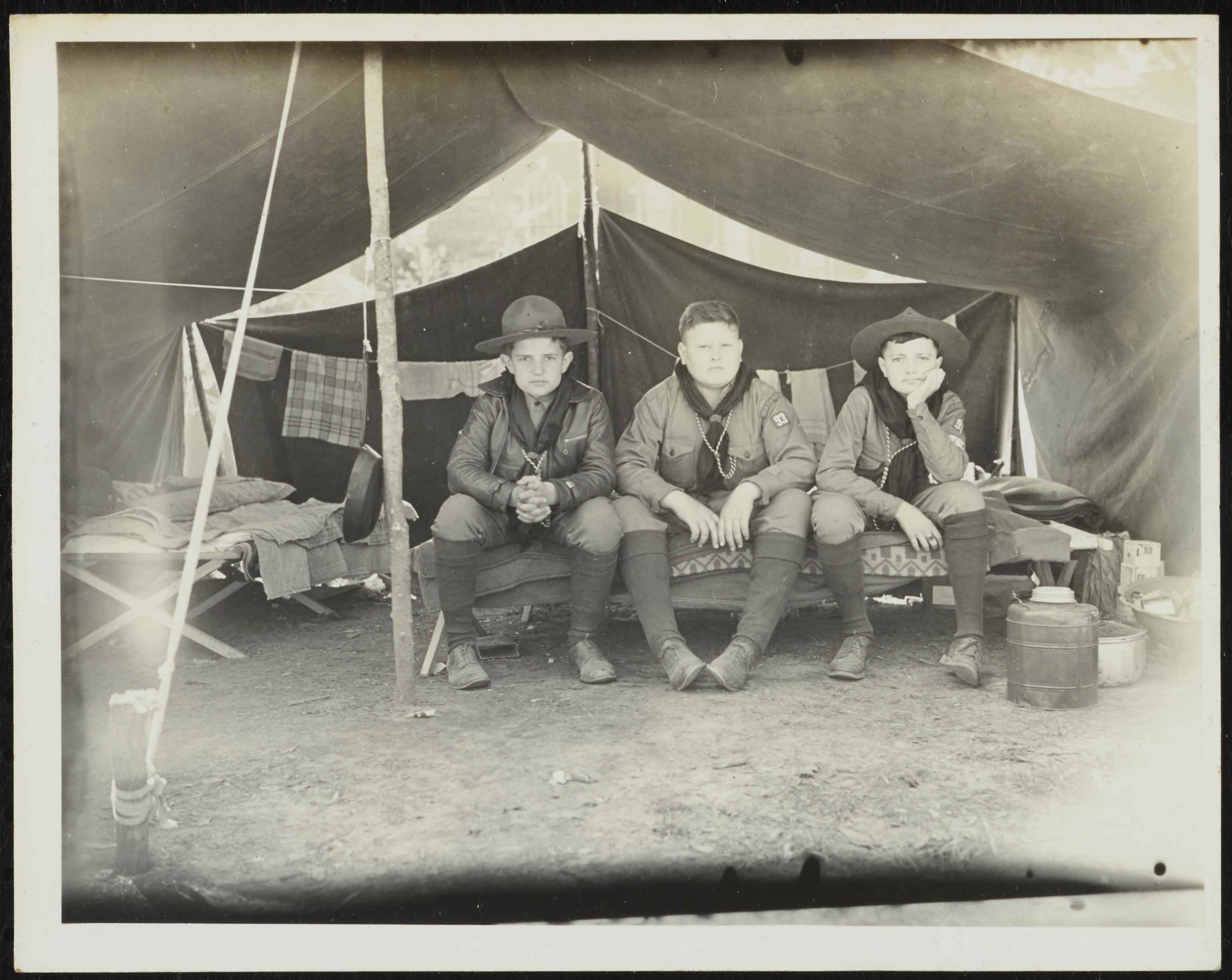
Boy Scout Camporie – Tarboro, Image 15
Milton Steele Brown, now well known to DigitalNC, owned a Coca-Cola bottling plant and Tarboro and was an active amateur photographer. With hundreds of individual and groups of photos already available online, this latest batch adds to the depth of the collection. Branching across many of Brown’s different subject interests, the batch includes additions to his Majorettes, Coca-Cola Bottling Plant and Horse Show objects. Some of the new subjects include Boy Scouts, Easter Egg Hunts, the Tarboro Milk Plant and trains.
To learn more about M.S. Brown and see all his photos available on DigitalNC, please visit the exhibit page or check out the DigitalNC Blog. To see all of the items contributed by the Edgecombe County Memorial Library, visit the contributor page or see their homepage.
Randolph County Public Library has contributed an additional Finer Carolina scrapbook to the others currently on DigitalNC. This scrapbook, from 1955, is similar to the others in this series. It includes photographs of the community service during that year’s Finer Carolina campaign – beautification and cleanup activities as well as social events like parades, plays, and contests. A miniature train, the Asheboro Flyer, was also installed.
You can view all of the Finer Carolina scrapbooks from Randolph County on DigitalNC.
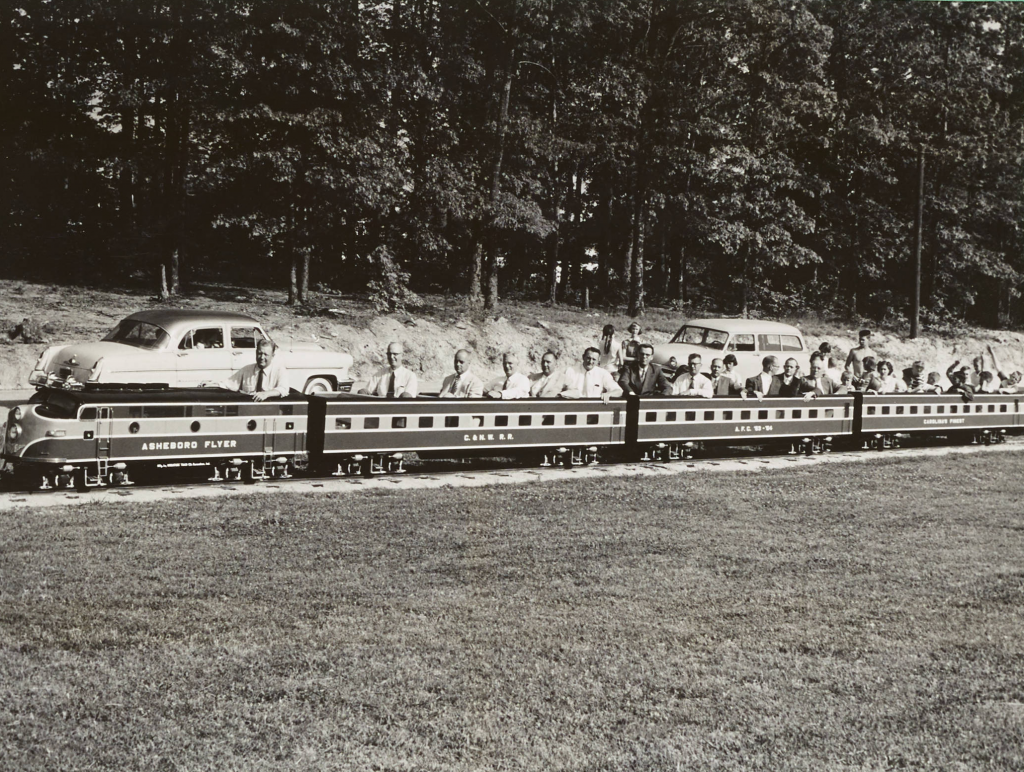
Miniature Train, Asheboro, 1955
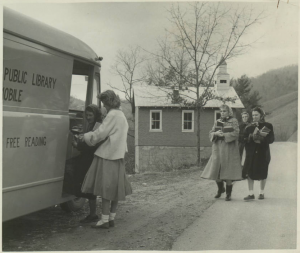
Patrons visiting the Madison County Bookmobile
A scrapbook compiled by Mrs. Peggy Dotterer covering the life of the Madison County Bookmobile through pictures and press clippings is now available on DigitalNC. A former school teacher, Mrs. Peggy Dotterer started the Madison County Bookmobile in the 1950s and ran it for 15 years until her retirement in 1970.
Three days a week she traveled the mountain roads, serving 2000 regular customers. She drove 1000 miles a month, 12 months a year. The other two days she spent at Madison County Library in Marshall, 20 miles north of Asheville.
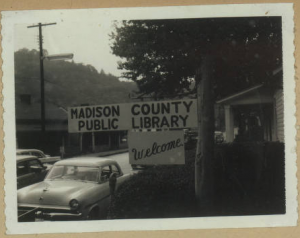
Entrance to the Madison County Public Library
Weekly columns in the newspaper kept patrons up-to-date about the comings (or not comings) of the Bookmobile. In the following column Mrs. Dotterer mentions that the radio station WWNC announces her schedule every morning.
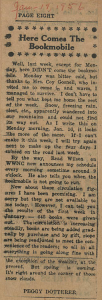
These materials and more can be found in the scrapbook, which is available courtesy of Madison County Public Library.

Mrs. Peggy Dotterer
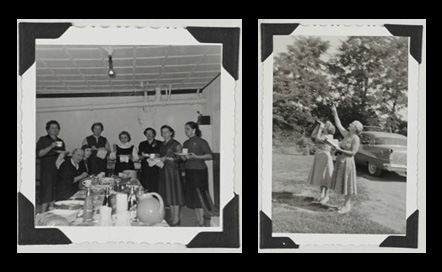
Several Yadkin County Home Demonstration Club Scrapbooks, from the collections of the Yadkin County Public Library, are now available online at DigitalNC. The scrapbooks were produced semi-annually by the Yadkin County Home Demonstration Club. The scrapbooks cover the club’s projects and events, and provide a unique snapshot of the social activities of women in rural North Carolina in the 1950s.
Some of the highlights from the 1957 scrapbook include “A Miss and Her Money,” a pamphlet published by the Institute of Life Insurance in 1956 to introduce money management to girls; several pages of recipes for refrigerator jams; rules for hosting and attending a tea party (p. 62); coverage of the annual Dairy Queen beauty contest; and an incredibly thorough treatise on the selection of household linens (p.92). The scrapbook also reports on the Home Demonstration Club’s participation in the Ground Observer Corps, a Cold War era civilian force which used binoculars or the naked eye to search the sky for threats from Soviet and Japanese aircraft (see photo).
Here is a 1956 recipe for Red Raspberry Jam featured on page 114 of the scrapbook:
Ingredients:
- 3 cups finely mashed or sieved red raspberries
- 6 cups sugar
- 1 package powdered pectin
- 1 cup water
Directions:
Combine fruit and sugar. Let stand about 20 minutes, stirring occasionally. Stir the pectin into the water, bring to boiling, and boil rapidly for 1 minute, stirring constantly. Remove from stove and let stand at room temperature 24-48 hours or until jelled. Seal with paraffin and store in a freezer. Or it will keep several weeks at refrigerator temperatures. Makes about 6 glasses.

Early issues of the Asheboro Courier are now available in the North Carolina Newspapers digital collection. More than 500 issues, ranging from 1884 to 1912, have been digitized. The Courier was one of the first newspapers to be published in Asheboro, tracing its origins back to 1876. Unfortunately, few early issues are available.
The Courier, boasting the lofty slogan “Principles, Not Men,” favored the Democratic Party in its coverage and editorials, promoting Democratic candidates at the local, state, and national level. The local coverage of the paper appears to be excellent, and the long social columns and many letters to the editor suggests that the paper was a true community institution.
The newspaper merged with the Randolph Tribune in 1940 to form the Courier-Tribune, which is still being published, making it one of the 10 oldest continuously-published newspapers in North Carolina.
 Early issues of the Highland Messenger, the first newspaper to be published in Asheville, are now available in the North Carolina Newspapers project. The Messenger began publication in 1840, when there were just a few thousand people living in Buncombe County. The initial goals of the paper were quite lofty. Here they are, as stated in the first issue:
Early issues of the Highland Messenger, the first newspaper to be published in Asheville, are now available in the North Carolina Newspapers project. The Messenger began publication in 1840, when there were just a few thousand people living in Buncombe County. The initial goals of the paper were quite lofty. Here they are, as stated in the first issue:
“Our paper shall be devoted to Religion, Morality, Science, Politics and General Intelligence, having for its leading object the instruction and advantage of the people, wherever it shall be attentively read.”
Like most papers published in this period, much of the content relates to national news and politics interspersed with a wide variety of features and short pieces, with little space given to local reports. However, it is possible, through the many advertisements, court notices, letters, and editorials to get a sense of the issues and concerns of the village that would, by the early 20th century, grow into what another paper would come to call the “mountain metropolis.”
We have recently digitized and published online several histories of Randolph County, North Carolina. Nominated or contributed by the Randoph County Public Library, these volumes will be of interest to current and former residents, as well as anyone interested in the histories of Asheboro, Seagrove, and other towns and communities in Randolph County. All of the titles can be viewed in their entirety online and the text can be searched by keyword. The books currently available on DigitalNC are:
- Randolph County, 1779-1979, published by the Randolph County Historical Society and the Randolph Arts Guild.
- Sketches of My Asheboro: Asheboro, North Carolina, 1880-1910, by Sidney Swaim Robins.
- The Architectural History of Randolph County North Carolina, by Lowell McKay Whatley, Jr.
- The Story of Naomi Wise and the History of Randleman, by the Rotary Club of Randleman, N.C.
- Seagrove Area, by Dorothy Cole Auman.
- Dan Tucker and other Randoph County Heroes in Folklore, by Barbara Presnell.
While North Carolina has fortunately not seen anything this year like the terrible floods currently affecting the Mississippi River, our state is no stranger to the tragedy and disaster caused by flooding. The Images of North Carolina collection currently has 98 different photos of floods and flood damage, showing floods in Rocky Mount, Ashe County, and Davie County.
This image, from the Charles S. Killebrew collection at the Braswell Memorial Library (Rocky Mount, N.C.), shows downtown Rocky Mount in 1962.

Among the hundreds of photos from the Ashe County Public Library that were recently added to DigitalNC is a wonderful scrapbook showing scenes from the early 20th century in Grassy Creek, N.C. “Grassy Creek Pictorial” was put together by the Ashe County Teacher Training Department and provides an interesting look at life in the rural community in the mountains on the North Carolina – Virginia border.















 Early issues of the
Early issues of the 

